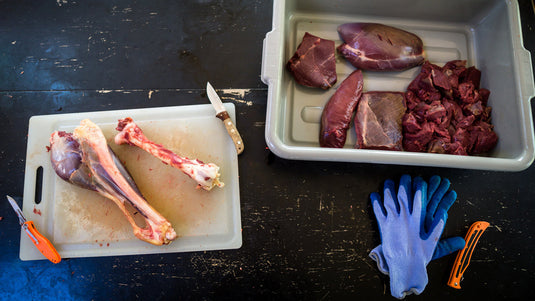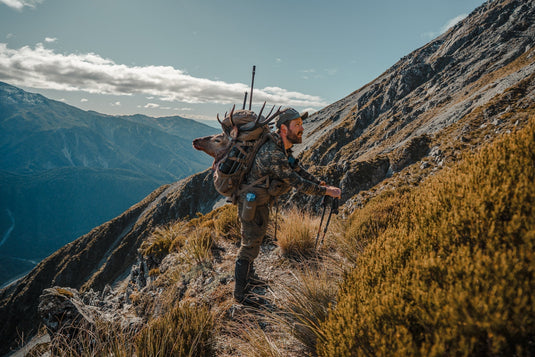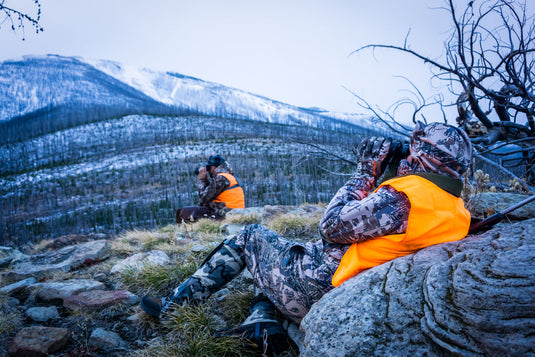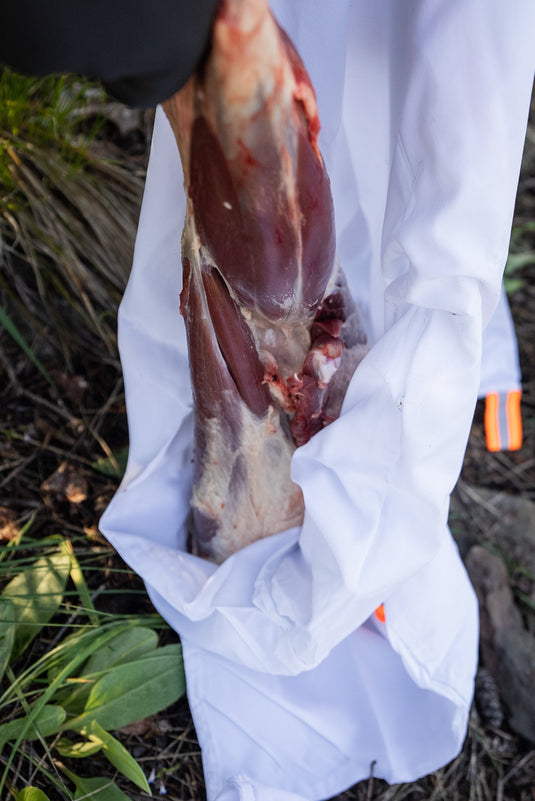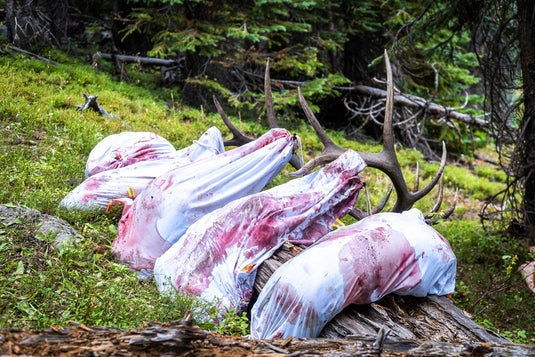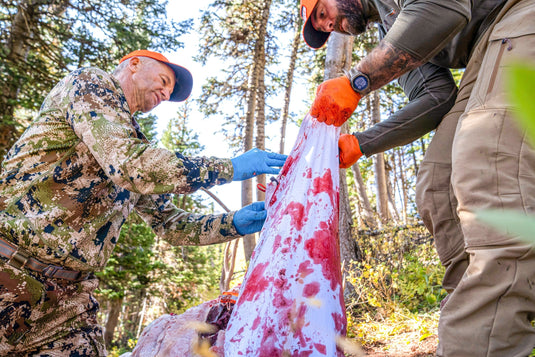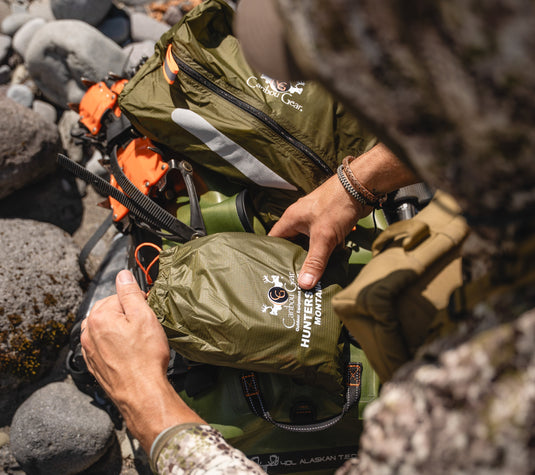If you intend to come home with the best-tasting, highest quality wild game meat this season, you need a detailed plan. That plan begins before you ever leave home. And it’s not complete until the meat is cut, packaged and in the freezer.
If handled properly, wild game meat should be the star on your dinner table throughout the year. Any “gamey” or off-putting taste is almost always the result of preventable mistakes. Whether you’re hunting in warm weather early in the season, or cold weather late in the season, there are some steps you should take to make sure you end up with the best possible results.
As you prepare for your hunts this year, here are 9 meat care tips to help you make the most of your wild game harvests:
1. Freeze Water Jugs Before the Hunt
A critical part of caring for any wild game harvest is getting the core temperature down as quickly as possible. This can be tough any time of year, but especially during early season hunts. Make the job easier by coming prepared with frozen water jugs in your cooler.
Don’t rely on a trip back to town for ice. That’s a waste of critical time when the spoilage clock is ticking. Instead, come with ice already in your cooler. Bagged ice is ok. But we highly recommend using frozen water jugs.
Frozen jugs offer a couple of advantages. First, it helps keep the meat from getting soaked in melted ice water. As ice in the jugs begins to melt, it will stay contained. The best scenario for any wild game meat is to keep it cool and dry. Second, frozen water jugs also last much longer than bagged ice.
It’s important to note that water jugs can take a long time to freeze – a gallon jug of water might take several days to freeze solid. I typically put them in my chest freezer a week before leaving on a hunt. If you’re filling empty jugs, leave enough head space for the ice to expand. If you’re buying new water jugs at the store, you’ll need to pour out a little bit before you stick them in the freezer, otherwise they’ll burst.
When it’s time to load up for your hunt, add the frozen jugs to your cooler and don’t open the lid until it’s absolutely necessary. Keeping that cooler sealed up will help the ice last much longer. If necessary, you can even bring a separate cooler for food so that you’re not constantly opening the one with the ice.
2. Prepare and Pack a Kill Kit
Next, start assembling your kill kit. This is a kit you’ll carry with you at all times while hunting. It will allow you to begin processing an animal in the field immediately. The faster you can quarter an animal and begin the cooling process, the better.
Our kill kit typically includes a knife, sharpener (or spare blades if you’re using a replaceable blade knife), game bags, latex gloves, hunting license and pen, zip-ties, paracord, Hunter’s Tarp, citric acid spray, and a bone saw if you intend to remove the skull cap. To learn more about building your kill kit, see our previous article here.
Most importantly, carry the kill kit in your pack whenever you are hunting. If your game bags and other essentials are back at the truck, you’ll waste valuable time when you meat could be cooling. Especially on those early season hunts, begin the field dressing and cool-down process as soon as possible.
3. Know How to Avoid Spoilage
When you think of spoiling meat, what are the first things that come to mind? Perhaps you think of warm temperatures or flies and other insects. But there are more pieces of the puzzle to consider.
First, take the time to consider which pieces of meat will spoil first. In most situations, any loose meat like backstraps, neck meat or deboned meat will be at the highest risk for spoilage. Loose meat has a tendency to hang down in a ball at the bottom of a game bag. As the weight of boneless meat compresses when hanging, air isn’t able to circulate properly.

Whenever you can, we recommend packing out bone-in quarters. This offers a couple of important advantages. First, you can hang quarters by the end of the shank and place a loose-fitting game bag around it. This provides maximum airflow. Second, leaving meat on the bone through rigor mortis prevents muscle “shortening” which can lead to tougher meat.
When it is necessary to debone an animal in the field, use game bags that are designed for boneless meat like our Carnivore bags. The long, tubular shape of these bags helps prevent meat from balling up at the bottom. Even so, do everything you can to promote circulation and then get the meat into a cooler or cold storage as soon as possible.
Finally, don’t underestimate the insulating power of a big game hide. Even in freezing cold weather, it’s critical to remove the hide from the quarters immediately to begin the cooling process. Every once in a while we hear hunters say that they leave the hide on the quarters instead of using game bags. We’re in the game bag business so we may be biased. But this is unequivocally a bad idea. Unless you enjoy gamey tasting meat, get that hide off right away.
4. Keep Meat Clean While You’re Field Dressing
As you skin back the hide, take extra care to keep hair off the meat. Inevitably, some hair will end up on the meat – especially when it’s windy or when working with thin-skinned animals like pronghorn. However, do your best to keep the meat clean as you go.
When skinning around glands or other smelly parts, take extra precaution. When using a replaceable blade knife, I will often change out the blade after skinning around the glands on a rutty mule deer. That way, I’m not tainting the rest of the meat with that pungent smell.
Keep in mind that using the gutless method of field dressing reduces the meat’s exposure to blood and other fluids, which helps prevent spoilage. If you do need to gut the animal, do your best to keep blood off the meat. Areas along the insides of the hindquarters that become soaked with blood are at a much higher risk to spoil. When this happens, give these areas a quick rinse with water and then pat them dry.
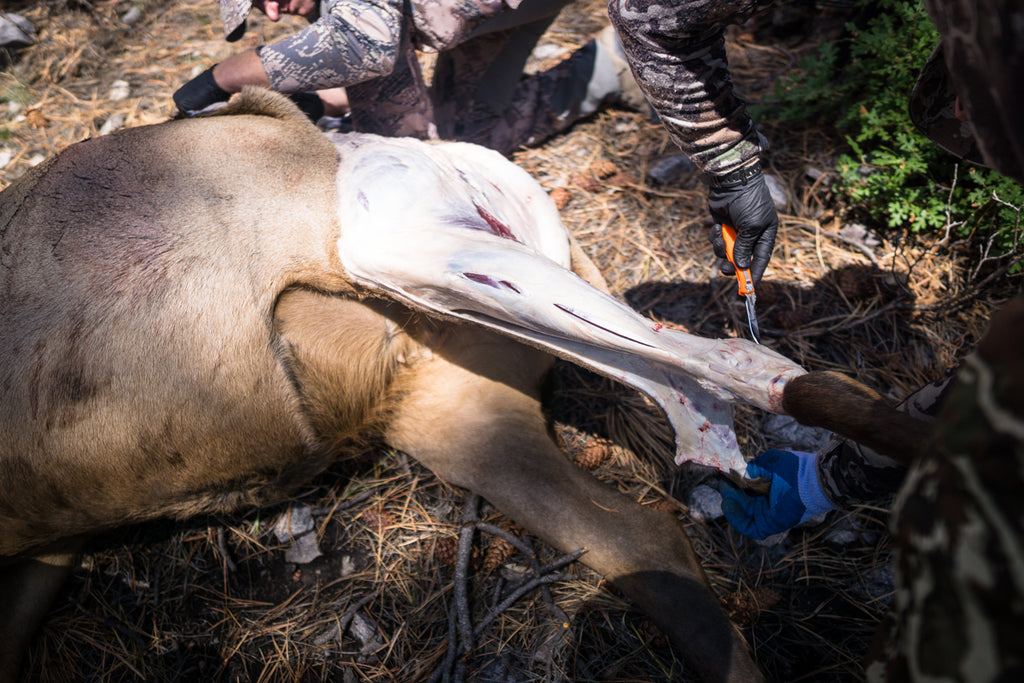
When the hide is removed, take each quarter directly from the carcass and place it into a clean game bag. Don’t set it down in the dirt or grass. Ideally, one person holds the bag open while the other person lifts the quarter into the bag. If you’re working alone or if you’re short on hands, use a Hunter’s Tarp to set the meat on a clean surface while you get it into a game bag.
When each quarter is placed into a game bag, place it on a clean Hunter’s Tarp or lay it over a nearby log where it will remain out of the dirt until you finish the rest of the animal. Wherever possible, keep it in the shade while you continue working. As soon as the hide is removed, that meat will begin cooling from its live body temperature down to the ambient air temperature. Shade and air circulation will help speed up that process.
5. Use High Quality Game Bags
Not all game bags are created equal. In fact, there’s a reason that Caribou Gear game bags are the world’s only patented game bags. You can say we’re biased. But those similar-looking bags made of less-breathable nylon materials are absolutely inferior.
Caribou Gear game bags are highly breathable. No cotton is actually used in the material. But they breathe so well, it acts like dry cotton. This allows air to circulate around the meat, providing the best possible conditions where the meat is both protected from dirt and insects, but also free to breathe. Those knock-off nylon game bags create a greenhouse effect. I’ve seen meat in those game bags become slimy in under an hour. It’s hard to overstate the importance of breathability.
In addition to being breathable, Caribou Gear game bags are also highly durable, lightweight and easy to clean. A set of game bags can easily last for many years. In fact I have a set of Wapiti game bags that are entering their seventh season of use!

It should go without saying – but don’t use a trash bag to haul meat. First of all, it’s not breathable and it will create an awful greenhouse effect. Additionally, most trash bags contain chemicals that you don’t want anywhere near your meat.
Finally, we’d also advise against using cheesecloth style game bags. These one-time use game bags are a waste of money for starters. But they’re also terrible for keeping meat clean and protected. Dirt can easily get onto your meat through the gaps. And flies will have no problem gaining access to your meat.
As an extra measure of protection, especially during early-season hunts, we highly recommend using citric acid spray. Food-grade citric acid can be sprayed right onto the meat. It is naturally anti-microbial, it repels insects and it’s a natural preservative. What’s more, it easily washes off when you’re ready to process the animal, leaving no taste. To learn more, see our previous article specifically about using citric acid.
6. Have a Plan to Cool Harvested Meat
When the quarters are skinned, removed from the carcass and carefully placed into high quality game bags, it’s time to think cool thoughts. Every situation will be different. The weather, the distance from the trailhead and the landscape itself are all variables. So before you leave home, make a plan for how you’re going to cool the meat as quickly as possible.
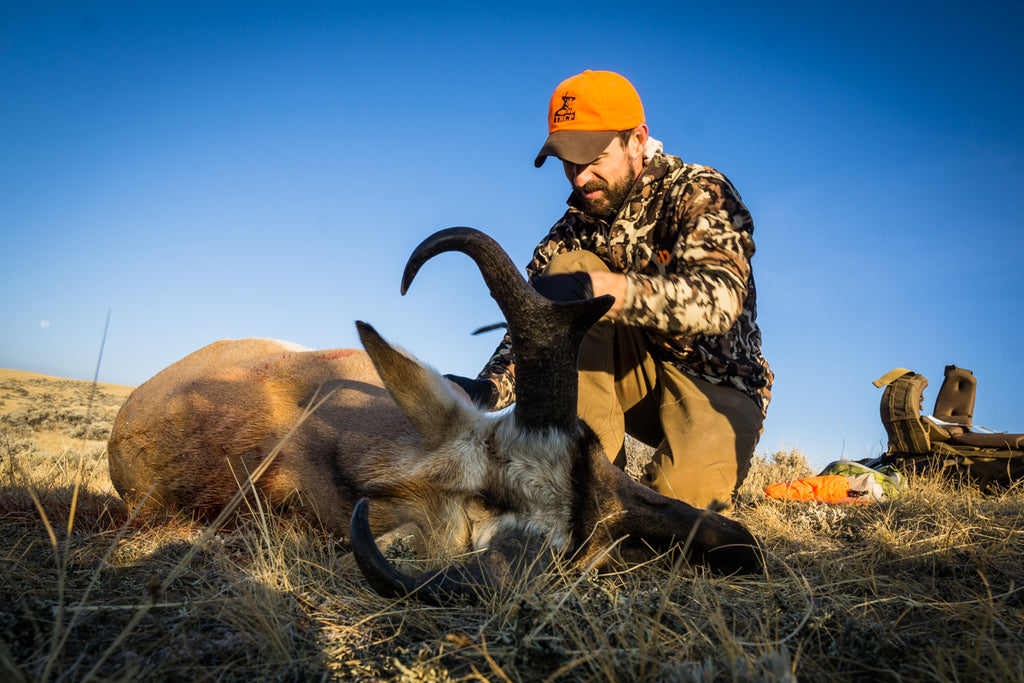
If you’re on an open country antelope hunt with no shade, the best plan is probably to get the meat back to the truck and into your cooler as quickly as possible. If you’re in more mountainous country, you can find cool places to hang meat, even early in the season. North-facing slopes are often shady and creek bottoms collect cold air. Find places where you can promote air circulation and quick cooling.
If you’ll need to make multiple trips back to the truck, take the time to care for the meat you’re leaving behind. Never leave it on the ground. Not only is it at risk of being scavenged, but air can’t flow around it when it’s on the ground. Whatever you can’t carry in the first load, hang it in a cool, shady spot until you can come back for it.
7. Hang a Tarp Over the Meat
Above, we mentioned using a tarp laid on the ground to keep meat clean while you’re field dressing an animal. Another great use for that tarp is to hang it over the meat. As we’ve mentioned before, clean, cool and dry is the ideal scenario for harvested wild game meat. That includes keeping it out of the rain or snow.
If you’ll be hanging meat overnight in a tree or on a meat pole at camp, take a few minutes to string a tarp over the meat. This will provide shade and protection from precipitation. Never place the tarp directly on the meat, as that would inhibit air circulation. Instead, suspend it above the game bags.

8. Wash Your Game Bags on Extended Trips
When hunting later in the season, cool weather can allow you to hang meat in camp for longer periods of time. This is nice when part of your group has filled their tags and others can continue hunting. If you plan to hang your meat for more than a couple of days, it can be a good idea to wash your game bags for better results.
Hang the quarters from a meat pole by the shank using paracord lashings. We provide pre-cut and tied lashings here. Inside the breathable game bags, quarters will begin to dry, forming a hard skin or rind. As this happens, debris like hair and stray leaves and grass will fall to the bottom of the bag.

The next day after you killed the animal, wait until evening and then pull the game bags off each quarter. It’s best to do this in the evening when bugs have disappeared for the night. Take a minute to wipe remaining debris from the meat, and spray it with citric acid. Again, see here for a more detailed look at why and how to use citric acid.
Next, take the game bags and place them in a 5-gallon bucket or plastic tub with cold water and a few drops of dish soap. Let them soak in the soapy water for about an hour. Then rinse the bags in a bucket of clean water. Make sure you’ve rinsed out all the soap and wring them out. Hang the game bags on a clothesline to dry overnight.
If you're in the backcountry or if you don't have access to a bucket or soap, simply rinse the game bags in a creek or lake. You'll notice that even without soap, most of the blood will rinse right out. Do your best to rinse off any pieces of dried fat or tissue to restore the breathability of the game bags. Wring them out well and then hang them to dry overnight.
In the morning, put the game bags back over the hanging quarters. Now, your meat can continue to hang in clean game bags. This process can be repeated if necessary. Even on extremely long hunts in remote parts of Alaska, Caribou Gear founder, Ted Ramirez has been able to keep meat in great condition for up to two weeks using this method.
9. Before Processing the Meat at Home
When you’ve made it home from your hunt and you’re ready to butcher the animal, there are a few more things you can do to help improve the quality. First, if it has been less than 24 hours since you killed the animal, it’s ideal to let it pass through rigor mortis before you begin butchering. Cutting meat off the bone before rigor has passed can cause a contraction of the muscles called shortening. This can lead to tough meat. Rigor mortis usually passes sometime after 24 to 48 hours.
In order to let rigor pass, you’ll need to keep all the meat clean, cool and dry. If conditions allow, you can hang it in a cool garage or shed at home. Otherwise, you’ll need to leave it in a cooler. Just be sure to keep it above the ice so that it stays as dry as possible.
If rigor has already passed and you’re ready to butcher, take some time to carefully clean the meat before you cut and package it. Make a quick vinegar-water solution (about a ½ cup distilled vinegar in a gallon of cold water). Using a clean cloth, wipe down the meat with the solution. Remove any remaining hair or debris from the meat. Then, carefully pat it dry.

If the quarters were hanging at camp for several days, this quick wash will rehydrate the outer layer of meat. There is no need to discard that rind – it is a perfect addition to your ground meat.
From there, how you cut it and package it is all up to you! Quality cuts like loins can be dry aged in a fridge on a wire rack or vacuum-sealed and then wet aged. But no matter how you choose to finish each cut, you can enjoy each piece, knowing that it was carefully handled from field to finished product!
We hope you enjoy some of your best wild game meat this season. If you have questions about meat care, game bags or anything related, please feel free to ask.

By Ryan McSparran
Ryan is an outdoor writer based in Colorado, and is proud to be a part of the team at Caribou Gear.








